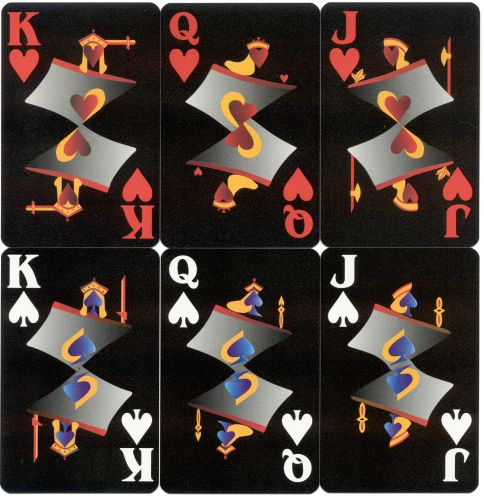 Leonor Décourt's
Leonor Décourt's
Maria  Leonor Décourt's
Leonor Décourt's
-1-
We first met Maria Leonor Décourt in Paris, when she was visiting the IPCS convention with her husband Cláudio in 1998. As a Brazilian artist with a degree in Architecture and Fine Arts, she has had many exhibitions in Brazil, but also in Italy, Holland and Portugal. In 1992 she received the Macunaima Award from the Brazilian Art Foundation (FUNART), being selected as one the best contemporary works presented. Her main activity is printmaking.
Her work can also be found in the public collections of several musea.
|
A
selection:
|
|
EPOC is Leonor's second playing card design. The first one was completed some years ago, also following the standards of the English pattern. Only one copy was made. The objective of both projects was to create a new design without overlooking the characteristics and purpose of a standard playing card pack.
 the
one-eyed Jack of Spades
the
one-eyed Jack of Spades ![]() and his attribute.
and his attribute.
We're not really connoisseurs of the anglo-american or international pattern, but we immediately recognized the "suicide King" (King of hearts) and the "one-eyed Jack" (Jack of Spades). Other courtcards also show the typical attributes of the anglo-american courts.
The EPOC deck was printed and published by the major Brazilian manufacturer of playing cards, COPAG. The title was derived from the four initial letters of the French suitmarks, as spelled in Portugese:
E for Espadas (Spades) P for Paus (Clubs) O for Ouros (Diamonds) C for Copas (Hearts)

Next to the design a large index -solid, but with an Art Deco elegance- and suitcolour were placed in 2 corners. The smaller "Q" was used in order to be able to place the suitcolours in the same place on each card. And not, as our first thought was, as a symbol for the role of most women in the - still a bit "macho"- Brazilian culture.

A lot of artists who have stepped outside their original discipline to design their own (nonstandard) deck, have a special bond with playing cards. For
example, Jean Verame is a French artist and........an avid collector of antique playing
cards. So it's not
a surprise that he created a deck in his own style and technique.
And what is
Leonor Décourt's bond with playing cards?
In her own words: "I
am fascinated about playing cards since my childhood. These objects are always
familiar to me, not only to play with, but also to present some tricks I learn
from my father, an amateur magician. I don’t know if by coincidence or not I
am now married with a lover and collector of playing cards… In that way my
links with cards was turned more and more strong."
At
the moment her husband, Cláudio Décourt, is president of the IPCS. He has been
collecting playing cards with the anglo-american or international pattern for a
long time and has presented a classification of this pattern during the IPCS
convention in London in 2003.
The Aces , jokers, extra card and some numbercards are on the next page.
-1- -2-